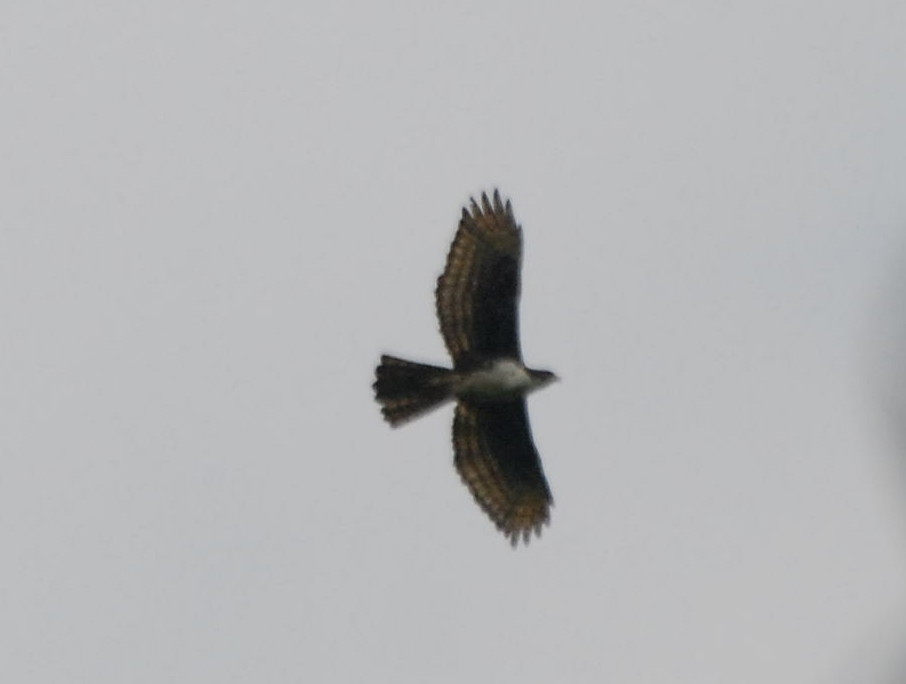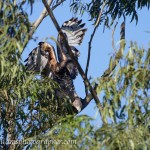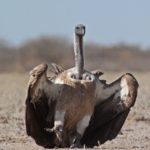Interview with Robbie Whytock about African Crowned Eagles and other raptors in the Ebo Forest
I met Robbie by chance in 2005 during his first visit to Cameroon. At the time I was based in Limbe, where the Ebo Forest Research Project offices are based, and Robbie was introduced to me by a mutual friend who shared his interest in birds. Robbie had arrived in Cameroon to work with another local conservation NGO with an interest in raptor conservation, but things seemed to be at a standstill. Robbie persisted, and during his time in Limbe he soon became known for his avian expertise. 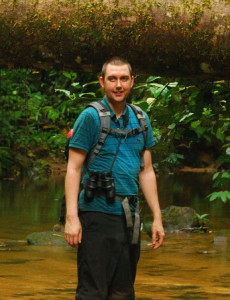
Most conservationists in Cameroon are focused on mammal conservation, and it was a breath of fresh air to meet someone with wider interests.
In 2008, we invited Robbie to work with us in the Ebo forest, initially as a volunteer and later as a research associate with the EFRP. Robbie had no formal scientific training at the time, but his knowledge of Cameroon’s forest birds and drive to master ecological research methods have resulted in three peer-reviewed publications in recent years. After two years of working with us, Robbie returned to the UK where he began an undergraduate degree in Ecology at Stirling University, graduating with first class honours in 2014. During that time he continued to return to Cameroon on a regular basis, and successfully secured funding to research the impact of bushmeat hunting on birds in the Ebo forest. These achievements led to him securing a funded PhD position at Stirling University in 2014.
Robbie’s enthusiasm for tropical forest biology, and ability to work effectively with local people, has made him a pleasure to work with. I expect he will make many more worthy contributions to bird conservation research in future, and I am delighted to be able to introduce him.
Bethan Morgan
Can you give us a quick overview about the ecology of the Ebo Forest (landscape, habitat, etc)?
The proposed Ebo National Park covers 1,100 km2 and is dominated by secondary lowland and sub-montane rainforest. There are also large areas of raphia swamp and marantacea forest and, where soil is thin on hill tops, small areas of savannah-like habitat. Much of the forest was inhabited until Cameroon’s independence in the 1950s and 60s, when civil war forced the population to abandon remote villages and move to the forest edge. The remains of abandoned villages can still be seen throughout the forest, with their locations marked by upturned iron pots and ageing stands of oil-palms. The terrain is challenging, with seemingly endless river valleys that undulate steeply between 250 m and 1100 m above sea level. The forest is particularly important for its primate community, with one of the largest known populations of drills, an endangered cousin of the better-known mandrill, as well as high densities of the endangered Nigeria-Cameroon Chimpanzee and a small population of Lowland Gorillas. There are two main seasons, distinguished by rainfall, with the wet season beginning in April, peaking in August and ending in October. Temperatures in the dry season peak at around 33oC, with lows of around 24 oC. Even in the dry season it is extremely humid, rarely dropping below 80%. The Ebo Forest Research Project operates a permanent conservation-research program in the forest, with two permanent research camps, one of which has been manned permanently since 2005.
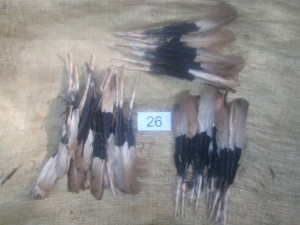
What raptor species are present?
We’ve so far recorded sixteen diurnal raptors inside the forest and at the forest edge. Yellow-billed Kite, Palmnut Vulture and African Harrier-hawk are the most abundant. Yellow-billed Kites scavenge for discarded food in villages, breeding in isolated trees above agricultural plantations. Palmnut Vultures and African Harrier-hawks are widespread throughout the forest edge and interior. Both species are generalists, and Palmnut Vultures in particular feed on a wide range of prey, ranging from palmnuts, giant African land snails, freshwater crabs and carrion discarded by hunters.
Other common species found at the forest edge include Black Sparrowhawks, which regularly take chickens in villages, as well as African Goshawks and Lizard Buzzards. Forest specialists, which are less well-known, include Crowned Eagle, Cassin’s Hawk-eagle and Congo Serpent-eagle, as well as Long-tailed Hawk, Red-thighed Sparrowhawk and Chestnut-flanked Sparrowhawk.
Red-necked Buzzards are occasionally seen at the forest edge, and I’ve once seen an African Fish-eagle. The most recent addition to the list was a European Honey-buzzard found with a broken wing near Bekob camp, a research station run by the Ebo Forest Research Project. I’ve also seen the occasional Common Kestrel, but these are normally quite far from the forest edge near larger villages and towns.
Owls are generally under-recorded in Ebo, but we’ve seen African Wood-owl, Barn Owl and Sandy Scops-owl. Others have also recorded Red-chested Owlet and Shelley’s Eagle-owl.
What are the challenges when studying raptors in the Ebo Forest?
There are two main challenges; the first is negotiating access to the forest with local people. It’s important that those who rely on the forest for economic and cultural reasons are involved in research and conservation activities, but sometimes they can feel that their livelihoods or cultural practices are under threat. It’s the responsibility of external researchers to work in co-operation with local people, and make the objectives of any research activities clear. This can be a long and slow process, involving lots of consultation with local chiefs and elders, often in several villages. Discussions can sometimes go on for several hours or even days.
The second problem is the forest itself, with endless mountains and dense vegetation it can be difficult just walking from a to b, never mind trying to actually see or hear a raptor!
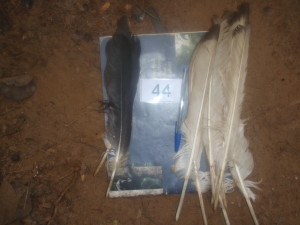
What raptors are hunted for bushmeat or other purposes?
We’ve so far recorded Cassin’s Hawk-eagle, Crowned Eagle, African Harrier-hawk, African Goshawk, Palmnut Vulture and remains of other unidentified raptors as bushmeat. Owls, such as African Wood-owl, are also killed due to superstition.
How is the Palmut Vulture affected?
Our 2014 study (published in the journal Oryx) found that Palmnut Vultures were the most commonly hunted raptor in the Ebo forest. This could be because they are the most common raptor in general, and therefore readily available to hunters, or because hunters target them specifically. We are currently conducting a study (funded by a Rufford Small Grant) to try and establish why people hunt and eat raptors, and to assess the sustainability of hunting pressure. At present we don’t know the impact that hunting is having on palm nut vulture populations, but it’s likely to be negative given the species’ low reproductive rate.
What is the status of the African Crowned Eagle in the Ebo forest?
When I first travelled to Ebo I hoped to find crowned eagles at similar densities to the Tai National Park, Ivory Coast (~ one pair per 6.5 km2). Instead it took months for us to hear our first bird, and it was more than a year before I saw one. I haven’t yet had the chance to systematically assess the status of the Crowned Eagle population, but I expect densities to be much lower than those found in Tai National Park.
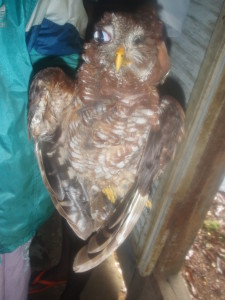
What is the main prey of the Crowned Eagle and how are the prey species affected by hunting?
In central African forests, Crowned Eagles will take a variety of prey ranging from duiker, colobus monkeys, guenons, other mammals and occasionally birds such as hornbills. All of these are heavily exploited for bushmeat throughout Central and West Africa, and many species are in decline as a result. Where hunting pressure is very high, colobus monkeys are among the most vulnerable species. These large monkeys feed on leaves, and once gorged with food they quickly lose their agility, have little stamina and are easy to hunt. In Ebo, Black and White Colobus have almost disappeared, and the endangered Preuss’ Red Colobus is hanging on in small numbers.
Although there is no firm evidence to suggest that bushmeat hunting has had either a direct or indirect impact on Crowned Eagles, it’s obvious that lower prey densities will at some point have an impact on predator populations. For example, research from Gabon suggests that Leopards are in direct competition with humans for prey (much like Crowned Eagles), and where hunting pressure is high, Leopard populations decline as an indirect consequence of hunting activity.
What is known about the ecology and status of the Cassin’s Hawk-Eagle in the Ebo Forest?
We know very little about Cassin’s Hawk-eagles. Like Crowned Eagles, we haven’t systematically estimated population densities in Ebo, but they are much more common than Crowned Eagles. I know of at least four territories in Ebo that occupy a total area of approximately 25 km2. This is four times higher than densities reported elsewhere (~ one pair / 100 km2). Pairs are often vocal, and display high above the forest canopy during midday. Territories always seem to be focused on steep-sided hills. On several occasions I’ve seen individuals soar high above a hilltop, then fly up to 1 km away from the hill before quickly descending into the canopy. The bird then disappears for some time, before reappearing out of the forest canopy at the same point on the original hill. This is repeated time after time. I expect this is a hunting strategy, with the birds flying away from the centre of the territory, high above the forest canopy to avoid being detected, and then hunting under the canopy as they return.
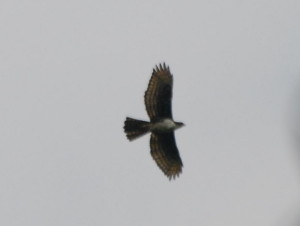
What needs to be done to reduce bushmeat hunting?
Despite some significant effort from international conservation NGOs and scientists over the past 25 years or so, there is no clear solution to the problem. People hunt and consume bushmeat for a variety of social and economic reasons, and these can differ greatly between communities. In Ebo, commercial hunters earn a living from hunting species that can be sold for cash in rural and urban markets, and this is the most damaging type of hunting. Subsistence hunters will shoot and trap close to farms and villages, and generally only target smaller species like squirrels or the occasional monkey. These are usually consumed by the hunter’s family or sold opportunistically.
Commercial hunting operates on a supply and demand basis, and unless we can cut the demand for bushmeat then it’s always going to be difficult to stop hunting. However, projects like the Ebo Forest Research Project can also have a positive impact, and hunting pressure in the vicinity of the project’s permanent research stations is greatly reduced, as hunters avoid the area fearing they could be caught.
There is a proposed National Park in the Ebo Forest. What is necessary so that the park can help raptor conservation?
It’s essential that the Ebo Forest is given full National Park status. Forests across Cameroon and Central Africa are being removed at an unsustainable rate to make space for agricultural industries and mining. Forest specialists, such as Cassin’s Hawk-eagle, cannot exist without intact forest, and the conservation outlook for these species is poor if we cannot preserve large, intact areas of lowland forest.
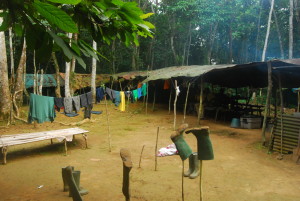
Is the area of the park large enough for a viable and long-term Crowned Eagle and Cassin’s Hawk-Eagle population?
The proposed park boundaries cover a large area (1,100 km2), and could certainly support a viable population of crowned eagles and Cassin’s hawk eagles. However, in the long term, populations are unlikely to persist in Ebo if the forest becomes isolated from other forest patches. Because of this we need to maintain a network of functional forest patches across the entire landscape.
How is the Crowned Eagle and other raptors affected by hunting in other parts of West Africa?
Very little is known about the status of forest raptors in West Africa. I spent two months in the Gola Rainforest National Park in Sierra Leone in 2013, and hunting pressure in general appears to be much lower there than in Ebo. Crowned Eagles were certainly far more common than in Ebo.
If tourists and bird watchers see illegally hunted raptors during their trips? What can they do?
Raptors are occasionally sold in markets or at roadsides in Cameroon, often alive. However, in these circumstances it’s important not to buy the bird, as this only encourages more hunting. There’s not an awful lot that can be done, but the Limbe Wildlife Centre in Southwest Cameroon has rehabilitated a number of raptors, including African Harrier-hawk, Palmnut Vulture, Black Kite and Fraser’s Eagle-owl, as well as thousands of parrots, so they would be worth contacting.
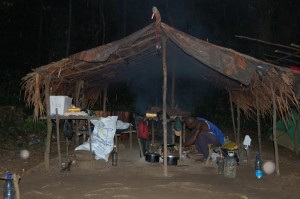
How do you see the future of the Crowned Eagle and the Cassin’s Hawk-Eagle in West Africa?
Both species might eventually end up being confined to a small number of isolated forest parks in West Africa. The story in Central Africa is different though, where there are still very large areas of contiguous forest with relatively low human population densities. These areas will likely become the last strongholds for many of Central and West Africa’s forest dependent species.
What future research is necessary to learn more about the ecology and conservation of African Crowned Eagles, Cassin’s Hawk-Eagles and other raptors in West Africa?
We know that both forest and savannah raptors in West and Central Africa are becomingly increasingly threatened by habitat loss, hunting, poisoning and the trade in body parts for traditional medicine. However, the biggest problem is the lack of basic population and demographic data for most species. It’s impossible to determine how big an impact that potential threats might have on raptor populations without this baseline data. In many parts of West Africa raptors are legally protected from persecution, but there is little or no enforcement of the legislation. Therefore, we need to understand where to focus our efforts, should it be on the bushmeat trade, or the trade in body parts for traditional medicine, or elsewhere? If we have baseline population data we can identify the most pressing issues, and begin to target conservation efforts at specific threats. In the long term, this kind of data is best collected by local ecologists, and I think that supporting local researchers will be the key to future conservation success in the region.
What tips would you give young researchers who want to get started with raptor research (or other bird species) in West Africa?
In Cameroon, the Department of Animal Biology at the University of Dschang is fast becoming a centre for ornithological research. Projects like the Ebo Forest Research Project and others run by organisations like the Wildlife Conservation Society also support local and international students. BirdLife International partners can also be a good place to begin making contacts, and they have a presence in many West African countries. The A. P. Leventis Ornithological Research Institute in Jos, Nigeria, provides specialist ornithological training as part of the University of Jos.
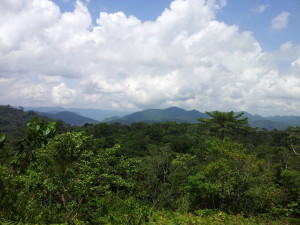
What was your most amazing experience with raptors in the Ebo Forest?
From a hilltop vantage point, I once watched a female Cassin’s Hawk-eagle soar high above the forest canopy, almost out of sight, before disappearing into the trees behind me. Then, 10 minutes later, I was shocked as she appeared just meters above my head, landing silently in a dead tree stood next to where I was sitting. She spent five minutes or so preening before moving off silently. I then decided to call it a day, and as I was packing up, a male Crowned Eagle appeared out of nowhere above the canopy and began displaying across the valley, giving the best views I’ve ever had of Crowned Eagles in Ebo! I didn’t even bother trying to take a picture or raise my binoculars, just enjoyed the scene.
Robbie, many thanks for the interview!

